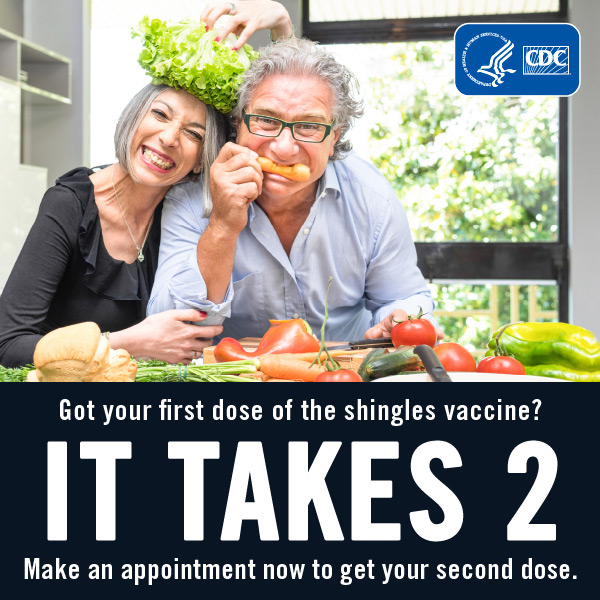Anyone who has had chickenpox in their lifetime may develop shingles. Shingles is a reactivation of the chickenpox virus (varicella zoster) in your body.
Shingles are a viral infection that causes a painful rash. The rash can appear anywhere on your body. A shingles rash commonly looks like a stripe of blisters that wraps around the right or left side of your torso.
Shingles are caused by the same virus that causes chickenpox. After you have had chickenpox, the (varicella zoster) virus remains in your body for the rest of your life. Decades later the virus may reactivate as shingles.
Symptoms of Shingles
Shingles symptoms usually develop on just one side of your body or face and in a small area. The most common spot for shingles to appear is in a band around the waistline or torso.
Pain is typically the first symptom of shingles. For some, the pain can be severe. Depending on the location, shingles pain can be mistaken for issues with the lungs, kidneys, or heart problems. Some patients feel pain from shingles without ever developing the typical rash.
Some symptoms of shingles can include:
- Pain
- Itching, Burning, or tingling
- Sensitivity to touch
- A raised red rash
- Fluid-filled blisters that can break and scab over
Some people may also experience:
- Headache
- Chills
- Upset Stomach
- Sensitivity to light
- Fatigue

Risk Factors for Shingles
Most adults born before 1980 in the United States had chickenpox as children. Before there was a routine childhood vaccination like the one now available to protect against chickenpox.
Anyone who has had chickenpox can develop shingles. Factors that increase your risk of developing shingles include:
Age – Your risk of getting shingles increases as you get older.
Shingles typically occur in people over 50 yrs. People over the age of 60 are at a higher risk for developing more severe complications.
Cancer Treatments – Chemotherapy or radiation treatments can sometimes lower your resistance to diseases and may lead to the activation of shingles.
Weakened Immune System – some diseases that weaken your body’s immune system such as cancer or HIV/AIDS, can increase your risk for shingles.
Some Drugs – Medications taken to prevent rejection of transplanted organs can increase your risk for shingles. Long-time use of steroids may also increase your risk of getting shingles.
Complications of Shingles
The most common complication associated with shingles is long-term nerve pain – postherpetic neuralgia or PHN. According to the Centers for Disease Control, 10-18% of people experience PHN after having shingles. PHN occurs when damaged nerve fibers send confused or exaggerated messages of pain from your skin to your brain. This painful condition can last for months or even years.
If left untreated, your risk for other complications related to shingles increases.
Some complications of shingles include:
- Vision loss or eye damage – if the virus gets in your eyes, it can cause painful eye infections that can lead to vision loss.
- Hearing loss or hearing damage – due to Ramsay Hunt Syndrome.
- Secondary Infections – such as bacterial skin infections and pneumonia.
- Neurological Issues – shingles can cause partial paralysis of facial muscles, brain inflammation (encephalitis), and permanent damage to your nervous system and spine.
Shingles Prevention – Vaccination
The good news, there is a vaccine to help prevent shingles. Shingrix is 90% effective at preventing shingles and long-term nerve pain.

Shingrix is an FDA-approved vaccine recommended for people over the age of 50 whether they have had shingles or not.
Shingrix is also recommended for patients who are over the age of 19 and have a weakened immune system due to medications or disease. People who have had the old version of the shingles vaccine (Zostavax) or who don’t know if they have had chickenpox may also get the Shingrix vaccine.
Plan to get Two Doses
You can get the Shingrix shot at your family doctor’s office or your local pharmacy. Talk to your doctor about your risk for shingles and about getting Shingrix.
The most common side effects of the Shingrix vaccine are redness, pain, and swelling at the injection site. Some patients also experience headaches, fatigue, and other side effects.
Check with your health insurance provider ahead of time to see if they cover the vaccine.
Plan to get your second shot of Shingrix 2 to 6 months after the first.
Getting a shingles vaccination is the only way to protect against shingles and PHN – postherpetic neuralgia, ongoing nerve pain that is the most common complication of shingles.
Anyone who has had chickenpox can develop shingles. Shingles is a painful illness typically involving a rash and sometimes leads to long-term nerve pain. As you age your chances of getting shingles increases. If you are over 50, you should talk to your doctor about getting vaccinated for protection against shingles.
If you’re concerned about shingles, want to get vaccinated, or have questions regarding shingles or the Shingrix vaccine, contact the caring professionals at River Bend Medical Associates for an appointment today. At River Bend Medical Associates, we care about your health and as part of your medical team, we are here to provide you with the best care in all aspects of your healthcare needs. For more information on our medical practice, or to make an appointment contact River Bend Medical Associates, or call 916-392-4000.


